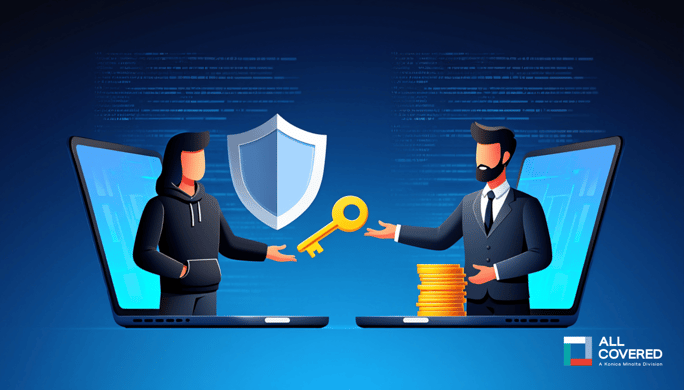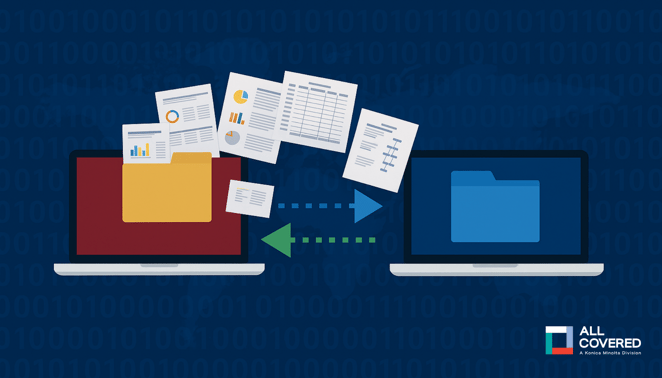Cybercrime isn’t what it used to be. It's more polished, profitable, and accessible. Enter ransomware-as-a-service, a business model that turns even low-level hackers into serious threats.
Here’s the scary part: they don’t even need to know how to code. They just subscribe to ransomware “kits” the same way you’d sign up for a streaming service. There are no tech skills required. Pick a plan, launch an attack, and wait for the ransom payments to roll in.
It’s not just nation-state hackers or cybercrime masterminds anymore. It’s anyone with bad intentions and a few bucks. And that means your business is at greater risk than ever.
The good news is that once you understand how ransomware-as-a-service works—and how these threat actors operate—you can defend yourself. In this guide, we’ll break down how it works, why it’s growing fast, and what you can do to stay ahead of it.
The Rise of Cybercrime-as-a-Service
In recent years, the “-as-a-service” model has transformed nearly every corner of the digital economy, from software and infrastructure to streaming and storage. This subscription-based approach offers scalable, on-demand access to powerful tools that are convenient for consumers, and increasingly, for criminals.
Cybercriminals have adopted the model with alarming efficiency. Malware-as-a-Service (MaaS), phishing-as-a-service, botnet rentals, and even access to stolen credentials are now readily available for purchase on underground forums and dark web marketplaces. These offerings come complete with customer support, user-friendly dashboards, and payment processing—no advanced hacking skills required.
This shift dramatically lowers the barrier to entry, enabling a wider pool of threat actors to launch sophisticated attacks. In particular, the rise of MaaS has led to a booming underground economy. Between 2015 and 2022, ransomware constituted 58% of all malware sold under the malware-as-a-service model, highlighting its dominance in the cybercrime-as-a-service ecosystem.
The impact is measurable. Businesses of all sizes, especially small and mid-sized organizations with limited security resources, have seen a sharp increase in targeted cyberattacks. The commodification of cybercrime tools has expanded the threat landscape and fueled a rise in the volume and complexity of attacks, making defense more challenging than ever.

What Is Ransomware-as-a-Service, Really?
Ransomware-as-a-Service (RaaS) is precisely what it sounds like—ransomware for rent. It’s a business model where cybercriminals create and sell ready-to-use ransomware tools to other criminals who don’t have the skills (or patience) to build their own. Think of it like a shady software subscription, but instead of helping you run a business, it allows bad actors to hold your files hostage.
Here’s how it usually works:
- Developers build the ransomware and maintain the platform, often complete with dashboards, customer support, and payout systems. These coders create the actual ransomware, build the backend infrastructure, and sometimes even offer customer support (seriously). They maintain the platform and handle updates to keep things running smoothly.
- Affiliates (the “clients”) sign up to use these tools, often on a profit-sharing basis. These folks do the dirty work of launching attacks, finding targets, and collecting ransom payments. Most of them have little to no technical expertise. They’re in it for a cut of the profits, and the platform makes it easy for them to jump right in.
- Targets, which include everyone from small businesses to huge enterprises, get hit when those affiliates launch attacks using the rented malware.
Also in the mix are initial access brokers, specialists who sell access to vulnerable systems, giving affiliates a way in without having to do the scanning or phishing themselves. And ransomware operators sometimes act as middlemen or orchestrators, managing campaigns and coordinating across multiple players.
The whole thing runs like a startup with bad intentions: low overhead, high ROI, and many eager users.
Why’s it so appealing? Simple. Affiliates don’t need to code or build anything. They pick a ransomware kit, plug in their targets, and let it rip. Profits roll in, and everyone stays anonymous thanks to cryptocurrency and dark web marketplaces.
No surprise, then, that in 2024, global ransomware attacks reached the highest number since 2021 with 5,263 incidents—a surge primarily driven by the rise of RaaS platforms.
Breaking Down the Ransomware-as-a-Service Business Model
Ransomware-as-a-Service isn’t just a tool—it’s a fully operational business model. Like any thriving startup, it has key players, revenue streams, and tactics designed to maximize profits. Let’s peel back the curtain and take a closer look at how this criminal ecosystem really works.
Common RaaS Revenue Models
Just like Netflix, the RaaS model comes with a few pricing plans:
- Flat monthly subscription: Pay a fixed fee and use the ransomware as much as you want, plus regular updates.
- One-time license fee: Buy the malware outright for lifetime use, no strings attached.
- Affiliate model: Affiliates share a percentage of ransom payments with the ransomware developers. Typically, the developers and affiliates split the profits 70/30 or 80/20.
- Pure profit sharing: No upfront cost, just a cut of the profits after a successful attack. You only pay the developer a cut when you get paid.
These flexible models make RaaS attractive to different types of cybercriminals, from casual opportunists to full-time operators.

Extortion Tactics Used
Gone are the days of simple “pay or lose your files” attacks. RaaS groups are running layered extortion campaigns to ensure their victims feel the heat.
Double extortion: Files are encrypted, and sensitive data is threatened with public exposure unless payment is made.
Multiple extortion: Add harassment, DDoS attacks, or even direct emails to customers and partners.
Pure extortion: No encryption at all. Just a threat to leak stolen data unless the ransom is paid.
Notable RaaS Examples
A few names have made serious waves in the ransomware world:
- LockBit: Highly active and constantly evolving. Known for fast attacks and a sleek, “professional” affiliate portal.
- Hive: Hit the healthcare and education sectors hard before being disrupted by law enforcement.
- REvil: Infamous for big-game hunting, targeting large corporations with deep pockets.
- Dharma: A “budget” ransomware with broad reach, often used against small businesses.
- BlackCat/ALPHV: A newer, more sophisticated RaaS strain written in Rust. Strong encryption and aggressive tactics.
What makes them successful? Easy-to-use kits, strong encryption, and marketing strategies straight out of Silicon Valley—except it’s all used for extortion.
These operations succeed by staying nimble, supporting affiliates, and constantly updating their playbooks to stay ahead of defenses. Their targets span industries from hospitals and schools to manufacturers and managed service providers.
Why Ransomware-as-a-Service Is Growing Fast
Ransomware-as-a-Service is booming, and it’s not slowing down anytime soon. Why? Besides the low barrier to entry, there’s the promise of big payouts with little risk of getting caught. Cybercriminals from around the world can now easily collaborate, sharing their tools and tactics on the dark web.
Then there’s the profit factor. Ransomware attacks can rake in huge payouts, especially from companies desperate to restore operations quickly. Combine that with near-total anonymity and no real consequences—especially when attacks are launched from countries with limited law enforcement cooperation—and you’ve got a perfect storm.
Global collaboration is another big driver. RaaS groups don’t operate in silos. They share tools, access, and tactics across borders. Forums on the dark web let developers, affiliates, and brokers connect, swap tips, and build powerful criminal partnerships.
Meanwhile, ransomware kits themselves keep getting better. They’re not just more accessible, they’re more sophisticated. Enhanced encryption, stealthier behavior, faster deployment, and slick affiliate dashboards are now the norm.
The result? Bigger, nastier attacks. Campaigns that once targeted individuals now hit hospitals, schools, city governments, and even entire supply chains. According to the Verizon 2025 Data Breach Investigations Report, ransomware showed up in 44% of all breaches, up from 32% the year before, and just 24% the year before. That’s a 37% jump in just one year.
When you make crime this easy, profitable, and global, it’s no surprise that ransomware-as-a-service is growing like wildfire.
The Real-World Risks for Businesses
Ransomware-as-a-Service doesn’t just live in the shadows of the internet; it hits real businesses, with real consequences. When an attack lands, the fallout can be brutal.
Downtime is immediate. Systems go dark, operations grind to a halt, and every minute offline costs money. Add data loss—whether encrypted, stolen, or both—and recovery becomes a nightmare. Even if backups exist, restoring full functionality takes time, resources, and a mountain of stress.
Then there’s the reputational hit. Customers, partners, and investors lose trust when they find out sensitive information was compromised or the business was disrupted. A ransomware attack can trigger severe compliance headaches for companies in industries with a lot of regulation, like healthcare or finance. Think HIPAA, GDPR, or PCI-DSS violations, plus fines and audits.
The financial toll doesn’t stop with recovery efforts. Many businesses feel pressured to pay the ransom, hoping to restore access and limit the damage quickly. In 2023, ransomware victims paid over $1 billion, a record high. But here’s the catch: paying the ransom isn’t recommended. There’s no guarantee you’ll get your data back, and it often funds future attacks.
At the end of the day, RaaS isn’t just a technical problem. It’s a business risk that’s hitting harder, faster, and more often than ever.
How to Protect Your Business from Ransomware-as-a-Service
There’s no silver bullet when it comes to ransomware protection, but there is a solid game plan. A mix of innovative tools, good habits, and prepared people can make all the difference when facing modern RaaS threats.
Have Backups and Recovery Plans
Backups are essential, but they’re not a get-out-of-jail-free card. Many attackers now encrypt backups or go after them first, knowing that businesses rely on them to recover. That’s why backup hygiene matters:
- Use off-site and offline backups that ransomware can’t easily reach.
- Test restore procedures regularly—a backup you can’t restore is useless.
- Keep multiple backup versions to roll back to a clean state if needed.

Keep Systems and Software Up to Date
Unpatched systems are basically an open door. Cybercriminals exploit known vulnerabilities all the time.
- Set up automatic updates whenever possible.
- Have a patch management process in place for everything from servers to employee laptops.
- Don’t forget that third-party tools like plugins, browsers, and even printer software can be entry points.
Train Your Team
Ransomware often starts with a single lousy click. Human error is still a top cause of breaches.
- Run phishing simulations so employees learn how to spot shady emails.
- Make cybersecurity training part of onboarding and ongoing education.
- Keep it engaging, because boring training gets ignored.
Implement Managed Endpoint Detection and Response (MEDR)
MEDR is like a security team watching your network 24/7, so you don’t have to.
- It catches threats early, even if they sneak past traditional antivirus software.
- You get real experts responding in real time, not just alerts piling up in an inbox.
- MEDR is an excellent option for SMBs without an entire in-house security team.
Build an Incident Response Plan
If an attack happens, panic isn’t a plan. A good incident response (IR) plan gives you clarity in the chaos.
- Include who does what, how to communicate, and how to recover.
- Test it regularly—think tabletop exercises or live drills.
- Follow NIST guidelines for building your IR plan.
Prevention is key, but preparation is power. The proper layers of defense can stop ransomware before it costs your business time, money, or trust.

Ransomware-as-a-Service: Make Sure You’re Protected
Ransomware-as-a-Service (RaaS) has made it easier than ever for cybercriminals to launch devastating attacks—no coding skills required. With low entry barriers, high payouts, and fast-moving campaigns, RaaS is a growing threat to businesses of every size. The risks are real and on the rise, from downtime and data loss to legal trouble and reputational damage.
Thankfully, you don’t have to face it alone. All Covered’s cybersecurity services give you expert protection, proactive monitoring, and peace of mind. Let’s build a security strategy that works—before ransomware hits.



